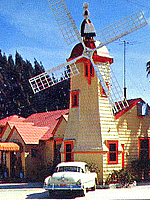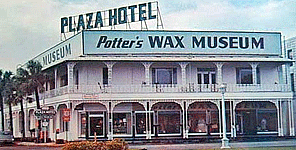
Signs of times gone by
Remembering history through business signs
By Geoff Dobson
Riding back from South Florida the other day, I spied a faded sign from long ago, a Stuckey’s Sign. Since the 1930’s, generations of Americans have known and loved Stuckey’s as a venerable roadside tradition. It was almost like seeing a “See Rock City” sign or viewing a series of Burma Shave signs.
The Stuckey’s sign brought back visions of pralines, pecan rolls and various souvenirs. Years ago, particularly in the South, there seemed to be Stuckey’s everywhere. The chain at its peak had over 350 locations, but then a large corporation took over. A large corporation does not necessarily have the same magic touch that its founder W. S. Stuckey, Sr. had. Stuckey’s shrank to less than 75 stores. It is coming back, however. It is now operated by the son of the original founder. At the next interchange I looked for a building with the distinctive teal colored roof. It was there, but it did not appear to be a Stuckey’s.
But, the point is that signs and building with distinct colors or architecture can bring back memories from an earlier time.
I thought about signs that have disappeared from St. Augustine, and buildings with distinct architecture that have vanished. They were a part of Americana. Restaurants such as Lums have gone. Lums was located on north San Marco and was famous for hot dogs — steamed in beer. Lums had red and white awnings.
Lums is not quite gone. Allegedly two remain; one in Bellevue, Nebraska, featuring home-cooked meals including liver and onions and a new one in Seekonk, Massachusetts. The last Lums that the writer visited was on Le Jeune Road near the airport in Miami. It is, of course, gone.
For the most part, Howard Johnson’s restaurants with their distinctive orange roofs and cupola are gone. The restaurants had frankfurts, clam dogs, and 28 flavors of ice cream. Howard Johnson hotels and motels remain but the traditional restaurants are almost gone. The last traditional Howard Johnson’s restaurant complete with “Johnson Girls” and 28 flavors of ice cream that the writer visited was in St. Petersburg some 35 years ago.
There were signs and buildings in St. Augustine that were distinctive and were a part of its persona. Those, too, are gone. Some towns take pride in their historic signs which are evocative of their history. Although the Rock Springs Coal Co. has been gone for over 70 years, Rock Springs, Wyoming, takes pride in the welcoming arches still proclaiming “ROCK SPRINGS COAL.” In Casper, there was a major uproar when the County Commission, after it had bought and renovated the old Townsend Hotel for a judicial center, proposed to paint over the old faded ghost sign on the North facing façade, “Hotel Townsend, Café and Coffee Shop.” Thus, the old sign remains on the judicial center.
 In St. Augustine, there were signs that were just as much a part of the town in years gone by as the Chevrolet “Bowtie” was a symbol of Times Square or the Hotel Townsend sign a symbol of Casper.
In St. Augustine, there were signs that were just as much a part of the town in years gone by as the Chevrolet “Bowtie” was a symbol of Times Square or the Hotel Townsend sign a symbol of Casper.
St. Augustine signs which are now gone include; the Exchange Bank time and temperature sign, the Plaza Hotel sign on the roof of what was Potters Wax Museum and the Marion Hotel sign on the roof of the Marion Hotel.
The most recent of the large roof top signs to go is the Florida East Coast Railway sign over its former headquarters on Malaga Street. The railroad headquarters had been a major presence in St. Augustine for over 100 years. When the sign came down, the presence of the railroad as a major component of the town disappeared. We lost a part of our history. Over the main entrance to the buildings, however, a small round sign with the Florida East Coast Railway logo remains.
The rooftop signs were as distinctive of St. Augustine as the Hollywood sign originally constructed to advertise a real estate development.
Gene Masters in Tallahassee had a painting of the waterfront of St. Augustine. The dominant feature of the painting was the Exchange Bank sign as viewed from the Bridge of Lions.
The Exchange Bank Building was originally constructed in the 1920’s and was first occupied by the First National Bank. The Exchange Bank followed and was locally owned. The Atlantic Bank in Jacksonville purchased Exchange Bank, followed by First Union National Bank, followed by Wachovia and finally (or currently) Wells Fargo National Bank.
As were buildings of the time, the elevators at 24 Cathedral Place were not automatic — but, run by elevator operators who would manually close the door and take one to the floor desired. Before the elevators were converted to automatic lifts, the interior of the two cars had in the grillwork the intials “FNB.” The initials remained long after the First National Bank folded in the Great Depression.
The difficulty with the lifts was on weekends. The elevator operators did not work on weekends. If one wanted to go to an upper floor, one ran the elevator one’s self and got off at the desired floor. And there the car remained. After both cars ascended to an upper floor, everyone else had to use the stairs. The elevators could not be summoned.
In the 1970’s and early 1980’s, a nationwide movement to eliminate commercial signs took hold. The movement led by Ladybird Johnson eliminated most “off premise” signs in non-commercially zoned areas. But the movement also let too many cities eliminating other commercial signage as being eyesores.
Signs were restricted in height and area. Indeed, many of the signs, such as the giant plastic statue for a local used car dealership, were perhaps a bit too much. Thus, ordinances were passed which amortized out the older signs and required that if they were taken down, they could not be replaced.
The Exchange Bank sign changed to an Atlantic Bank sign, but by the time the Atlantic Bank became “First Union,” the ordinance had taken effect and the sign came down. And it was the same with the Plaza Hotel sign when the building was sold. Of course, a sign with a different name would not carry with it the sense of history and nostalgia that the Plaza sign had. The Marion Hotel was torn down and thus it and its sign disappeared into the fog of time.
Over the years, others designed their buildings so that the structure itself was the sign. Perhaps, the most famous example was the Brown Derby restaurant.
During the 1940’s and 1950’s, all types of businesses throughout Florida operated out of unusual structures. In Orlando there was a motel in which all of the individual cabins were in the shape of teepees. What Plains Indian teepees had to do with Florida or Orlando is one of those mysteries of life.
In Citra, north of Ocala, an Orange shop continues to operate out of a giant orange.
The writer’s favorite of all time, was the gas station in Weekiwachee Springs constructed in the shape of a Sinclair Dinosaur. Sinclair has withdrawn from the Florida market, but the dinosaur remains as a reminder of a previous day.
In St. Augustine, the Windmill Restaurant on the east side of the Bridge of Lions constructed in the shape of a windmill is gone. Of buildings which themselves were constructed as attention getters, there remain the Mill Top and the Sugar Mill. Reverting back to an earlier period, a new museum has opened up on San Marco Avenue constructed in the shape of a palisaded fort.
But today, the only reminder of the days of rooftop signs in the area is the Santa Maria. Even its sign, however, has become more modest. It at one time advertised “Santa Maria, Old Spanish Landing Restaurant.”
Geoff Dobson, a St Augustine resident for the past 33 years, is a western and Florida history writer and was former General Counsel for the Florida Department of Transportation. He is a former president of the St. Augustine Historical Society and a regular contributor of nostalgic memories to Historic City News. Before his parents moved to Florida, his father was a Black Angus cattleman. Geoff has written extensively on Wyoming history (“Wyoming Tales and Trails”). When Geoff was in high school, his family lived in the cattle country of eastern Sarasota County. The family spread, which his parents called “Wild Cat Slough,” was reachable only by a pair of ruts over the sand hills and through a snake and gator infested slough. Now, it is an area of four-lane roads, expensive subdivisions, shopping centers, and office parks. . His undergraduate degree is in history. Geoff received his post-graduate degree from the University of Florida. He may be reached at ho****************@***il.com
Discover more from HISTORIC CITY NEWS
Subscribe to get the latest posts sent to your email.


Comments are closed